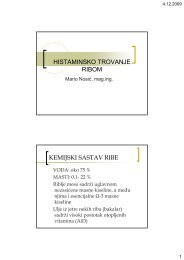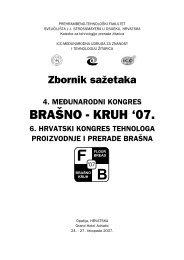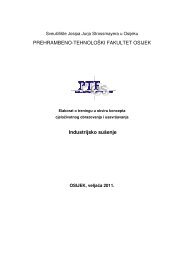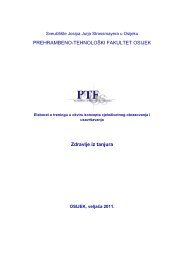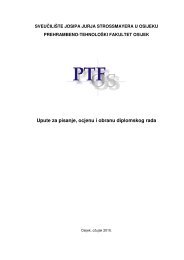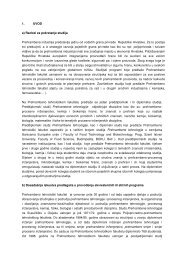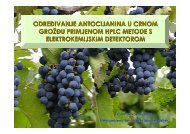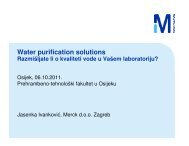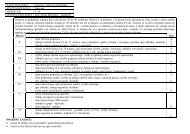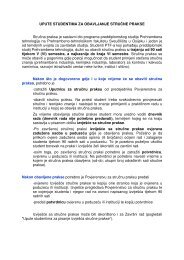ENGLISH IN FOOD TECHNOLOGY I
ENGLISH IN FOOD TECHNOLOGY I
ENGLISH IN FOOD TECHNOLOGY I
Create successful ePaper yourself
Turn your PDF publications into a flip-book with our unique Google optimized e-Paper software.
ADDITIONAL READ<strong>IN</strong>G<br />
UNIT 1<br />
IS NANO<strong>TECHNOLOGY</strong> GO<strong>IN</strong>G TO CHANGE THE FUTURE OF <strong>FOOD</strong><br />
<strong>TECHNOLOGY</strong>?<br />
Victor J. Morris Institute of Food Research Norwich, United Kingdom<br />
Nanotechnology is seen by many as a growth area that will transform tomorrows' world. Most<br />
countries in the world see nanoscience and nanotechnology as important. In Japan expenditure<br />
was $400M in 2001 and is expected to be $960M in 2004. The USA's 21st Century<br />
Nanotechnology Research and Development Act, passed in 2003, has allocated approximately<br />
$3.7B from 2005-2008, compared to an expenditure of $750M in 2003. In Europe current<br />
funding for R&D in nanotechnology is around €1B, much of which is funded through national<br />
and regional programmes. In the United Kingdom the DTI initiative on Micro- and<br />
NanoTechnology Manufacturing offers £45M in support of commercial applications between<br />
2003-2009.<br />
To consider the potential, and to address concerns, the UK<br />
government commissioned the Royal Society and the Royal<br />
Academy of Engineering to carry out an independent study<br />
into current and future developments in nanosciences and<br />
nanotechnology. Their report was published in July 2004 1 .<br />
Although the report does not specifically address the impact<br />
on the food industry, it does discuss bionanotechnology, and<br />
potential developments in computing, materials and sensors.<br />
It also addresses concerns about the safety and systems by<br />
controlling the shape and size at the nanometre scale.<br />
Some of the nanostructures in food are familiar compounds.<br />
Many food proteins are globular structures between 10s to<br />
100s nm in size - true nanoparticles. The majority of<br />
polysaccharides and lipids are linear polymers less than one<br />
nm in thickness, and are examples of 1 dimensional<br />
nanostructures. When foams are prepared and stabilised and<br />
emulsions formed, 2 dimensional nanostructures are created,<br />
one molecule thick, at the air-water or oil-water interface.<br />
Setting a gel, or adding polymers to delay the sedimentation<br />
of dispersions or the creaming of emulsions, generally<br />
Figure 1. Schematic diagram<br />
of an atomic force microscope.<br />
Like an old-fashioned<br />
gramophone a sharp probe<br />
attached to a flexible<br />
cantilever tracks the<br />
undulations of the sample<br />
surface. The resulting motion<br />
of the cantilever is monitored<br />
and used to generate a 3D<br />
image of the surface.<br />
involves creating 3 dimensional nanostructures, by causing food biopolymers to assemble into<br />
fibrous networks. When starch is boiled to make custard, small 3 dimensional crystalline<br />
lamellae 10s nm in thickness are melted. The texture of the paste or gel formed on cooling<br />
depends on the re-crystallisation of starch polysaccharides, as does the long-term staling of<br />
bakery products.<br />
Where there is a detailed understanding of the nanostructures present in food, rational<br />
approaches to the selection of new materials can be used, or quality through food processing<br />
can be enhanced. Protein crystallography provides atomic resolution information on protein<br />
structure. Site-directed mutagenesis allows the protein structure to be modified systematically,<br />
46



